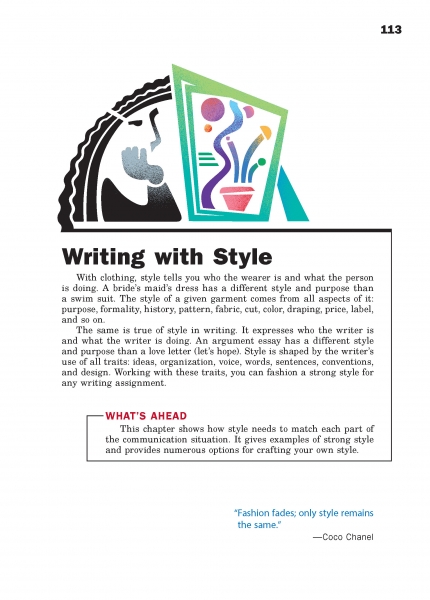Page 113 from

Start-Up Activity
Think of a student in your class who has a strong self-image and a hairstyle that is completely different from your own. Announce to the class that you think you'd like to try the person's hairstyle. After the laughter, ask students why they think your idea is a bad one. Students might point out that the hairstyle is too "young," or too "trendy," or too "edgy" for a teacher. They might point out that you don't have the right kind of hair (or a sufficient quantity of hair) to pull off the style. They might say your hair is too straight or curly or kinky, or too thick or thin or nonexistent. In the end, the problem is that the style just doesn't suit you for a variety of reasons.
Use this discussion to introduce the idea of writing style. It needs to suit the writer, representing the person well. It needs to connect with the audience. It needs to achieve the purpose of the writing and work with the subject and type of writing. Just as your students can recognize an effective hairstyle, they can recognize effective writing style. This chapter will help them do so.
Think About It
“If I want to knock a story off the front page, I just change my hairstyle.”
—Hillary Clinton

Start-Up Activity
Think of a student in your class who has a strong self-image and a hairstyle that is completely different from your own. Announce to the class that you think you'd like to try the person's hairstyle. After the laughter, ask students why they think your idea is a bad one. Students might point out that the hairstyle is too "young," or too "trendy," or too "edgy" for a teacher. They might point out that you don't have the right kind of hair (or a sufficient quantity of hair) to pull off the style. They might say your hair is too straight or curly or kinky, or too thick or thin or nonexistent. In the end, the problem is that the style just doesn't suit you for a variety of reasons.
Use this discussion to introduce the idea of writing style. It needs to suit the writer, representing the person well. It needs to connect with the audience. It needs to achieve the purpose of the writing and work with the subject and type of writing. Just as your students can recognize an effective hairstyle, they can recognize effective writing style. This chapter will help them do so.
Think About It
“If I want to knock a story off the front page, I just change my hairstyle.”
—Hillary Clinton
